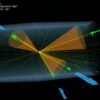Professor Ariando and Dr. Stephen Lin Er Chow from the National University of Singapore (NUS) Department of Physics have designed and synthesized a groundbreaking new material—a copper-free superconducting oxide—capable of superconducting at approximately 40 Kelvin (K), or about minus 233°C, under ambient pressure.
Nearly four decades after the discovery of copper oxide superconductivity, which earned the 1987 Nobel Prize in Physics, the NUS researchers have now identified another high-temperature superconducting oxide that expands the understanding of unconventional superconductivity beyond copper oxides.
The promise of superconductors
Modern electronics generate heat and consume energy during operation. Superconductors, however, possess a unique property known as the zero-resistance state, which eliminates energy loss due to electrical resistance. In theory, this makes them ideal for modern electronic applications, addressing the world’s growing energy demands.
Despite the discovery of thousands of superconducting materials, the vast majority function only at extremely low temperatures near absolute zero (0 K), or about minus 273°C, making them impractical for widespread use.
The 1987 Nobel Prize breakthrough
Nearly 40 years ago, physicists Johannes Bednorz and Karl Müller discovered a new class of superconductors—copper oxides—which exhibit superconductivity at temperatures above 30 K, significantly higher than any previously known superconductors.
This breakthrough, which earned them the Nobel Prize in Physics, laid the foundation for high-temperature superconductivity research. To this day, copper oxides remain the only superconducting oxides that function at temperatures above 30 K, or about minus 243°C, under ambient pressure, without requiring lattice compression.
A breakthrough beyond copper
In a series of studies, Prof Ariando and Dr. Chow identified a direct correlation between interlayer interactions in layered systems and superconducting temperatures.
Building on this insight, the researchers developed a phenomenological model that predicted several compounds capable of high-temperature superconductivity, similar to copper oxides, but without copper.
The team successfully synthesized (Sm-Eu-Ca)NiO₂ nickel oxide, one of the predicted materials, and confirmed zero electrical resistance (superconductivity) well above 30 K in this compound. The research breakthrough was published in Nature on 20 March 2025.
Dr. Chow stated, “As we predicted and designed, this non-copper-based superconducting oxide demonstrates high-temperature superconductivity under atmospheric pressure at sea level, without the need for additional compression—just like copper oxides. This finding suggests that unconventional high-temperature superconductivity is not exclusive to copper but could be a more widespread property among elements in the periodic table.”
“This observation has profound implications for both theoretical understanding and experimental realization of a broader scope of superconducting materials with practical applications in modern electronics,” added Prof Ariando.
“This is the first time since the Nobel-winning discovery that a copper-free high-temperature superconducting oxide has been found to function under ambient pressure. Additionally, this new material is highly stable under ambient conditions, significantly improving its accessibility.”
This discovery has sparked growing interest, not only in the material itself but also in the broader potential for a new class of high-temperature superconductors.
Discover the latest in science, tech, and space with over 100,000 subscribers who rely on Phys.org for daily insights.
Sign up for our free newsletter and get updates on breakthroughs,
innovations, and research that matter—daily or weekly.
Further research and future implications
The research team continues to investigate the material’s unique properties, exploring tuning parameters such as electronic occupancy shifting and hydrostatic pressure. These efforts aim to deepen the understanding of high-temperature superconducting mechanisms and pave the way for synthesizing a broader family of superconductors with even higher operating temperatures.
Another contributor to this work is Zhaoyang Luo, an NUS Ph.D. student with the research team, who demonstrated the high crystallinity and pure-phase nature of the synthesized material using electron microscopy.
This breakthrough represents a major step toward the development of next-generation superconducting materials, with practical applications in modern electronics and energy-efficient technologies.
More information:
S. Lin Er Chow et al, Bulk superconductivity near 40 K in hole-doped SmNiO2 at ambient pressure, Nature (2025). DOI: 10.1038/s41586-025-08893-4
Provided by
National University of Singapore
Citation:
Physicists discover a copper-free high-temperature superconducting oxide (2025, March 27)


